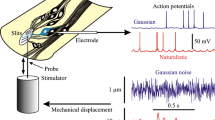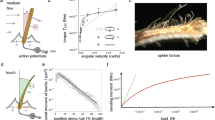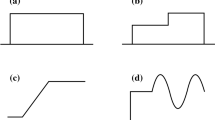Abstract
An important problem in neuroscience is to obtain quantitative knowledge of how information is represented, or encoded, in the signals that nerve cells process and transmit. Sensory receptors have provided important models for the study of neural coding because their inputs can often be relatively easily controlled and measured, while the resultant activity is recorded. A variety of engineering concepts have been successfully applied to physiological sciences, particularly those related to control of dynamic systems. Linear systems analysis was one of the earliest methods used to probe sensory coding, and measurements such as step responses and frequency responses have become standard tools for describing sensory functions. Modern systems analysis has evolved to provide accurate and efficient linear identification of encoding in sensory receptors that use either graded potentials or action potentials. It has also led to nonlinear systems analysis, the creation of parametric nonlinear models, and measures of information coding by sensory neurons. These methods promise to provide important new knowledge about sensory systems in the future, especially when complemented with parallel biophysical and molecular studies of sensory neurons. Mechanoreceptors provided some of the earliest preparations for the investigation of neural coding, and both the linear and nonlinear properties of wide variety of vertebrate and invertebrate mechanoreceptors continue to be explored.
Similar content being viewed by others
References
Bendat JS, Piersol AG (1980) Engineering applications of correlation and spectral analysis. Wiley, New York, 302 pp
Brown MC, Stein RB (1966) Quantitative studies on the slowly adapting stretch receptor of the crayfish. Kybernetik 3: 175–185
Bryant HL, Segundo JP (1976) Spike initiation by transmembrane current: a white noise analysis. J Physiol 260: 279–314
Chapman KM, Smith RS (1963) A linear transfer function underlying impulse frequency modulation in a cockroach mechanoreceptor. Nature 197: 699–700
Cooley JW, Tukey JW (1965) An algorithm for the machine calculation of complex Fourier series. Math Comput 19: 297–301
French AS (1984) The receptor potential and adaptation in the cockroach tactile spine. J Neurosci 4: 2063–2068
French AS, Butz EG (1973) Measuring the Wiener kernels of a non-linear system using the fast Fourier transform algorithm. Int J Ctrl 17: 529–539
French AS, Holden AV (1971) Alias-free sampling of neuronal spike trains. Kybernetik 8: 165–171
French AS, Marmarelis VZ (1999) Nonlinear analysis of neuronal systems. In: Windhorst U, Johansson H (eds) Modern techniques in neuroscience research. Springer, Berlin, pp 627–640
French AS, Torkkeli PH (1994) The time course of sensory adaptation in the cockroach tactile spine. Neurosci Lett 178: 147–150
French AS, Torkkeli PH (2008) The power law of sensory adaptation: simulation by a model of excitability in spider mechanoreceptor neurons. Ann Biomed Eng 36: 153–161
French AS, Wong RKS (1977) Nonlinear analysis of sensory transduction in an insect mechanoreceptor. Biol Cybern 26: 231–240
French AS, Höger U, Sekizawa S-i, Torkkeli PH (2001a) Frequency response functions and information capacities of paired spider mechanoreceptor neurons. Biol Cybern 85: 293–300
French AS, Holden AV, Stein RB (1972) The estimation of the frequency response function of a mechanoreceptor. Kybernetik 11: 15–23
French AS, Sekizawa S-i, Höger U, Torkkeli PH (2001b) Predicting the responses of mechanoreceptor neurons to physiological inputs by nonlinear system identification. Ann Biomed Eng 29: 187–194
Gammaitoni L, Hänggi P, Jung P, Marchesoni F (1998) Stochastic resonance. Rev Mod Phys 70: 223–287
Hodgkin AL, Huxley AF (1952) A quantitative description of membrane current and its application to conduction and excitation in nerve. J Physiol 117: 500–544
Hunter IW, Korenberg MJ (1986) The identification of nonlinear biological systems: Wiener and Hammerstein cascade models. Biol Cybern 55: 135–144
Juusola M, French AS (1997) The efficiency of sensory information coding by mechanoreceptor neurons. Neuron 18: 959–968
Juusola M, de Polavieja GG (2003) The rate of information transfer of naturalistic stimulation by graded potentials. J Gen Physiol 122: 191–206
Koles ZJ, Smith RS (1974) Characteristics of the sensory discharge of the muscle spindle in Xenopus laevis. Kybernetik 15: 99–110
Korenberg MJ (1991) Parallel cascade identification and kernel estimation for nonlinear systems. Ann Biomed Eng 19: 429–455
Landgren S (1952) On the excitation mechanism of the carotid baroreceptors. Acta Physiol Scand 26: 1–34
Levin JE, Miller JP (1996) Broadband neural encoding in the cricket cercal sensory system enhanced by stochastic resonance. Nature 165–168
Marmarelis VZ (1993) Identification of nonlinear biological systems using Laguerre expansions of kernels. Ann Biomed Eng 21: 573–589
Marmarelis PZ, Marmarelis VZ (1978) Analysis of physiological systems: the white-noise approach. Plenum Press, New York, p 487
Marmarelis PZ, Naka KI (1972) White noise analysis of a neuron chain: an application of the Wiener theory. Science 175: 1276–1278
Matthews PC, Stein RB (1969) The sensitivity of muscle spindle afferents to small sinusoidal changes in length. J Physiol 200: 723–743
Mitsis GD, French AS, Höger U, Courellis S, Marmarelis VZ (2007) Principal dynamic mode analysis of action potential firing in a spider mechanoreceptor. Biol Cybern 96: 113–127
Moore GP, Perkel DH, Segundo JP (1966) Statistical analysis and functional interpretation of neuronal spike data. Annu Rev Physiol 28: 493–522
Perkel DH, Bullock TH (1968) Neural coding. NRP Bull 6: 221–348
Pringle JW, Wilson VJ (1952) The response of a sense organ to a harmonic stimulus. J Exp Biol 29: 220–234
Rescigno A, Stein RB, Purple RL, Poppele RE (1970) A neuronal model for the discharge patterns produced by cyclic inputs. Bull Math Biophys 32: 337–353
Rieke F, Warland DD, de van Ruyter Steveninck R, Bialek W (1997) Spikes. Exploring the neural code. MIT Press, Cambridge, p 395
Shannon CE, Weaver W (1949) The mathematical theory of communication. University of Illinois Press, Urbana, 117 pp
Spekreijse H, Oosting H (1969) Linearizing: a method for analysing and synthesizing nonlinear systems. Kybernetik 7: 22–31
Stein RB (1967) The information capacity of nerve cells using a frequency code. Biophys J 7: 797–826
Stein RB (1980) Nerve and muscle. Plenum Press, New York, p 265 pp
Stein RB, French AS, Holden AV (1972) The frequency response, coherence and information capacity of two neural models. Biophys J 12: 295–322
Thorson J, Biederman-Thorson M (1974) Distributed relaxation processes in sensory adaptation. Science 183: 161–172
Torkkeli PH, French AS (2002) Simulation of different firing patterns in paired spider mechanoreceptor neurons: the role of Na+ channel inactivation. J Neurophysiol 87: 1363–1368
Volterra V (1930) Theory of functions and integral and integro-differential equations. Dover, New York, p 232 pp
Warland DD, Landolfa MA, Miller JP, Bialek W (1992) Reading between the spikes in the cercal filiform hair receptors of the cricket. In: Eckman F (eds) Analysis and modeling of neural systems. Kluwer Academic, Boston, pp 327–333
Watson JD, Crick FH (1953) Molecular structure of nucleic acids: a structure for deoxyribose nucleic acid. Nature 171: 737–738
Author information
Authors and Affiliations
Corresponding author
Additional information
This article is part of a special issue on Neuronal Dynamics of Sensory Coding.
Rights and permissions
About this article
Cite this article
French, A.S. The systems analysis approach to mechanosensory coding. Biol Cybern 100, 417–426 (2009). https://doi.org/10.1007/s00422-008-0262-9
Received:
Accepted:
Published:
Issue Date:
DOI: https://doi.org/10.1007/s00422-008-0262-9




